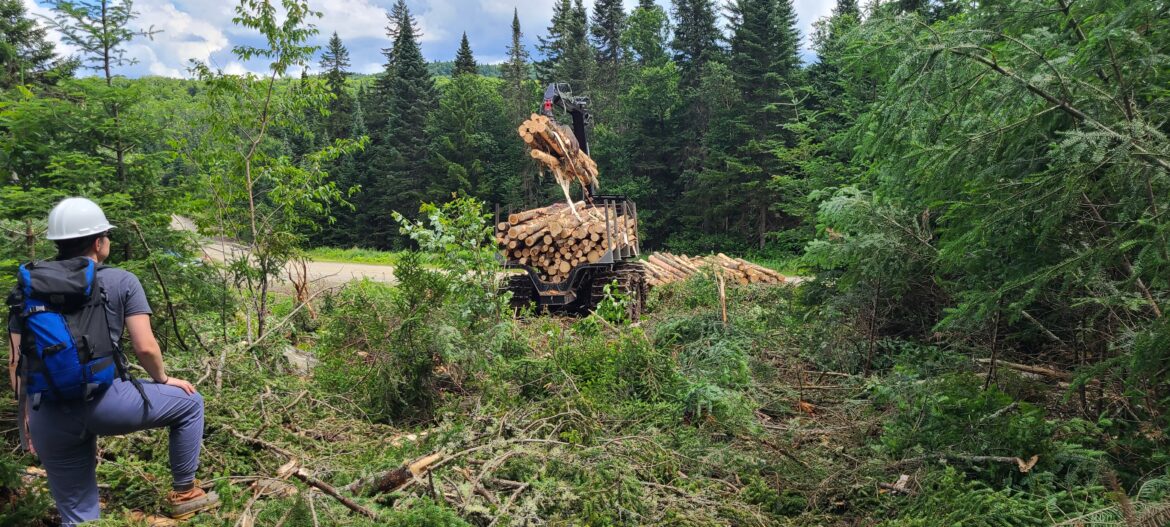By PAULA TRACY, InDepthNH.org
CONCORD – Concerned at the potential loss of timber tax revenue for its members with carbon “farming” replacing logging in this heavily forested state, the New Hampshire Municipal Association cautioned the state about agreeing to logging reductions in a 10-year plan on the 146,000-acre Connecticut Lakes Working Forest as part of the state’s easement.
This land, located in Pittsburg, Stewartstown and Columbia, represents about 4 percent of the state’s land mass at the northern tip of New Hampshire. Over the years, it provided for the region’s “wood basket,” fueling mills and keeping loggers and truckers moving.
When International Paper put the vast tract up for sale, the state and federal government worked to buy an easement on it to protect logging, recreation and other traditional uses. But 20 years ago when it was drafted, it never envisioned a future where the value of the timber would be more if left standing.
Rather than cut the trees for revenue as in the past, the new owner, Aurora Sustainables, https://aurorasustainablelands.com/ can get financial yield by keeping the trees standing for companies that want or need to get to zero carbon emissions. The company has the land enrolled in a California carbon market and is planning to reduce its annual cut from previous years if the state allows it.
Though it has raised its projections from 10,000 to 20,000 cords a year which the state rejected, to 20,000 to 30,000 cords in its new offer that the state is now considering, it is not the traditional 40,000 cords a year or more since 2003. And foresters say it is well under its annual growth rate.
And all of this impacts the towns and cities that get a 10 percent tax on all of the stumpage.
In a Nov. 25 letter to Sarah L. Stewart, commissioner of the NH Department of Natural and Cultural Resources from Margaret Byrnes, the executive director of the NH Municipal Association writes that, “In addition to negatively affecting the three towns impacted by this easement, all municipalities in New Hampshire need to be confident that the state will honor agreements and act in the best interest of our communities and taxpayers.”
“We urge the state to put New Hampshire communities first and honor the original intent of the easement,” Byrnes stressed.
NHMA is a nonprofit membership organization that includes all 234 cities and towns as members.
While Byrnes noted this specific issue affects only ” three of our towns—Columbia, Pittsburg, and Stewartstown—the precedent that could be set for easements across the state is significant in this matter and therefore is relevant to all cities and towns in New Hampshire.”
Stewart, reached at her office on Tuesday, declined to comment on the matter, noting she is currently in negotiations with Aurora.
Also watching the issue closely is Executive Councilor Joe Kenney, a Republican from Wakefield who serves much of the north country.
He said Tuesday he was thankful that the New Hampshire Municipal Association sees that this is a vital issue.
“I praise the NHMA for stepping in to support the North Country, their comments are direct and to the point. Maintain the Connecticut Headwaters property as a working forest to support local timber tax revenue and to support harvesting for our local loggers. The North Country forest product economy is at stake otherwise,” Kenney said.
The state levies a tax of 10 percent on the stumpage value of timber.
It requires that the owner notify the municipality through a notice to cut, which estimates the yield of volume to be extracted.
That tax revenue is collected from the final sale of the timber and paid to the town for general use.
In some towns, that can be a hefty sum.
In the case of Pittsburg, which has the largest acreage on the Connecticut Headwaters tract of the three towns, before Aurora bought the land and reduced logging, the town was getting about $175,000 a year in timber tax to cover town needs on a $2 million budget, noted retired Selectman Steve Ellis.
This year it is getting a payment in lieu of taxes, but the future remains uncertain in terms of timber tax.
In 2023, only 15,000 cords were cut. That is down from 52,373 cords in 2008, according to state data.
New Hampshire is 82 percent forested and the majority of it is timber land.
The issue of how to extract state revenue is about to be at play in the halls of the State House.
One possible legislative bill would be to enable municipalities to tax standing wood on land used for carbon sequestration, adding to RSA 79:3 related to timber taxation.
That measure, in title form only at this point, is sponsored by state Rep. Arnold Davis with other north country co-sponsors.
A bill that passed last session looks to the state to create a registry of all properties if they are being used for carbon.





